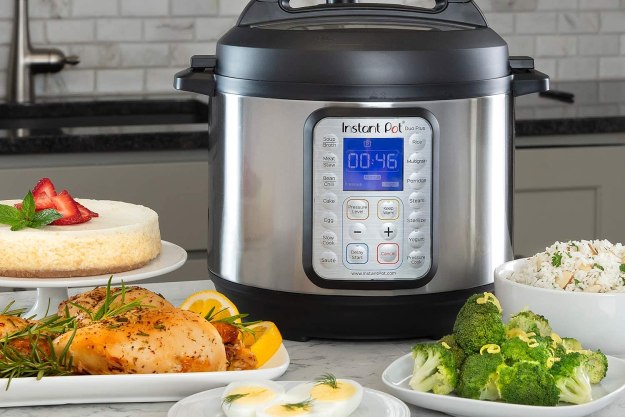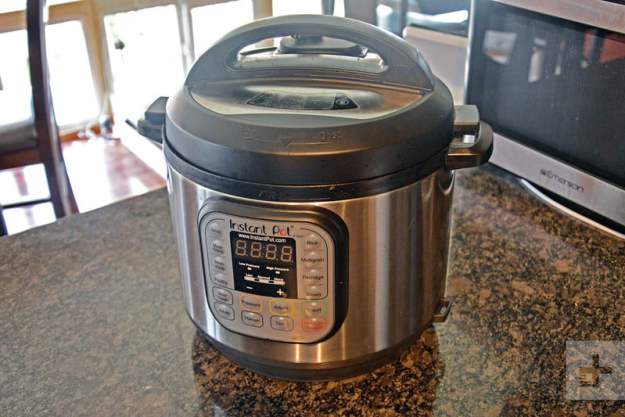Instant Pot is the end-all-be-all of small kitchen appliances, and a perfect amalgamation of slow cookers, pressure cookers, and a number of other crafty countertop devices. You can roast beans, steam veggies, braise meats, and more, all in a fraction of the time it would normally take you to cook these foods in the oven. The Instant Pot is a recipe champion, but, until you know how to use it, veteran cooks and newbs alike are all on equal footing.
Check out our easy-to-follow instructions, tips, and tricks for using your brand new Instant Pot.
What is pressure cooking?
The primary function of most Instant Pot models is pressure cooking. The pressure is what allows the Instant Pot to be such a versatile cooking appliance. But what exactly is pressure cooking? It’s a food-preparation method that seals the food inside a vessel with liquid, using heat to create steam, which increases the pressure in the vessel.
The appliance then traps or releases steam to control the level of pressure. With more pressure, the boiling point of the liquid rises, and the food cooks faster at a higher temperature. Pressure cooking retains the flavors and nutrients of your food while also creating moist and delicious results and saving energy in the process.
How do I use the settings?
The front of your Instant Pot can look pretty complicated, with all the different buttons denoting various programs. But once you understand what all the buttons mean, it’s pretty straightforward. Basically, each button refers to a different cooking method and has a preset cook time and pressure setting to make things more user-friendly.
| BUTTON | PRESSURE SETTING | COOK TIME |
| Slow Cook | Normal | 4 hours |
| Pressure | Low or high | Manual |
| Soup | High | 30 minutes |
| Meat/Stew | High | 35 minutes |
| Bean/Chili | High | 30 minutes |
| Poultry | High | 15 minutes |
| Rice | Low or High | Auto |
| Multigrain | High | 40 minutes |
| Porridge | High | 20 minutes |
| Steam | High | 10 minutes |
| Yogurt | 3 programs | Manual |
| Saute | N/A | Manual |
| Manual | Defaults to high (can be adjusted) | Manual |
| Adjust | N/A | N/A |
| Timer | N/A | Manual |
| Keep Warm/Cancel | N/A | N/A |
On some models, there will just be a “Pressure Level” button that you’ll push to change the pressure levels. A high pressure setting indicates the Instant Pot is cooking at high pressure, and the lid is sealed to keep the pressure trapped. A low pressure setting indicates lower pressure, but the appliance is still pressure-cooking.
As for cook times, some recipes come with preset times, while others require you to manually input how long you want the cooking process to be. The “Keep Warm” setting will automatically turn on when cooking is done.
Some Instant Pot models have additional features and functions as well. For Instance, the Instant Pot Duo SV has a sous vide cooking program, and the Instant Pot Duo Crisp has an air frying function.
How to release pressure
There are two ways to safely release pressure from the Instant Pot: The natural release method and the quick-release method. Some models perform these functions automatically, and other models have pulse release, but quick and natural release are the most common release methods.
Natural release lets the pressure slowly dissipate on its own, depressurizing as heat gets released from the lid. Depressurization can take between 10 and 30 minutes, depending on how much liquid is in the cooking pot. Recipes with more liquid will take longer to depressurize than dishes with less. The natural release method lets food stay intact during the depressurization process, as there is less movement within the appliance. Foamy foods or dishes with lots of liquid are best left to the natural release method. According to Instant Pot, to speed up the process, you can place a cold towel on the metal portion of the lid to help the appliance cool down faster.

To use the quick-release method, you can manually turn the steam release valve to the “venting” position. This cools the cooker down faster and only takes 1 or 2 minutes to completely depressurize. The company deems the steam release handle as a safe mechanism for letting steam quickly escape from the pot. The quick-release method is ideal for foods like salmon and crab that you don’t want to overcook, or vegetables such as broccoli and bok choy that cook very quickly. However, keep in mind that it is not recommended when cooking recipes with high starch content, as the quick release method can result in food bubbling out from the valve.
Please note it is crucial to wait until all the steam has been released from the Instant Pot before taking off the lid. It’s not safe to open the lid before the depressurization process is over. Your Instant Pot should have safety locks so that you can’t open the lid before depressurization is completed.
How to clean an Instant Pot
It isn’t difficult to maintain an Instant Pot, which is one reason why they’re so much more convenient than other kitchen appliances. All you need to do is wash your Instant Pot’s lid, sealing ring, and insert each time you cook. Then just give the outside of the pot a quick wipe to rid it of any food residue, and you’re good to go.
Trouble closing your Instant Pot almost always means that it’s time to deep clean it.
First, peel off the silicone sealing ring and remove any greasy residue that might be keeping the pot from closing correctly. Other small parts, like the steam release handle, anti-block shield, or float valve may get sticky after a while, too, so it’s a good idea to clean these parts occasionally in addition to cleaning the rest of your Instant Pot. That’ll help keep stubborn residue or food particles from building up. Don’t neglect to clean the Instant Pot’s spoon rest and recess additionally, to get rid of any accumulated grease and grime.
Editors' Recommendations
- The most common Google Home problems and how to fix them
- Best Instant Pot deals: Pressure cookers, air fryers and grills on sale
- The best Instant Pots for 2022
- The best pressure cookers for 2022
- How often should you use your robot mop



